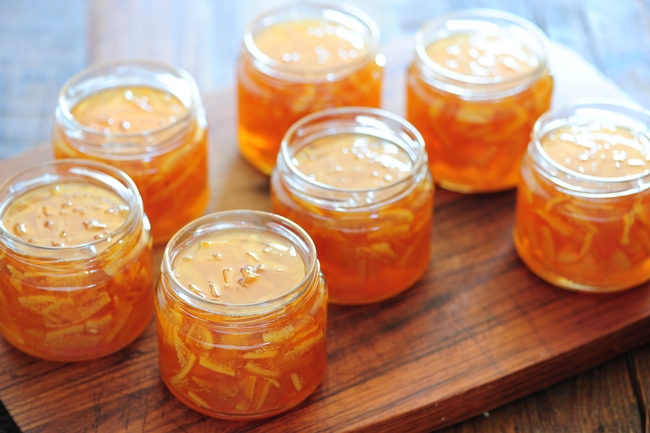
Posts Tagged: watermelon
Preserving and eating citrus peels and watermelon rind
Growing up, my parents told us stories of how as kids, they kept from starving during the Great Depression by not letting anything edible go to waste. To stay alive, they learned to eat beef tripe (stomach lining), chicken feet, cow tongue and other things not normally consumed. It was their stories that got me interested in learning about and sharing information on parts of fruits and vegetables normally discarded that can be preserved and eaten. Examples include citrus peel and watermelon rind.
The next time you eat an orange, grapefruit, tangerine or other citrus, you don't need to throw out the peel. Instead you can dehydrate it. Remove the pith (the white fibrous material between the skin and the peel) before placing the peel in your food dehydrator. You can also dry your peels in other methods, such as in the oven. Visit the National Center for Home Food preservation (www.nchfp.uga.edu) for more information on these alternative methods. For more information on dehydrating orange peels, see https://anrcatalog.ucanr.edu/pdf/8199.pdf.
What do you do with the dehydrated citrus peel? You can use the dried peels to add flavor to teas, or boil them to infuse the flavor in soups or rice. You can also grind the dried peels into a powder and sprinkle it on yogurt, salads, baked goods and other edibles for added flavor.

Fresh citrus peels are also often candied. The process basically involves simmering the peels in either a sugary syrup or corn syrup. You can find recipes on how to candy citrus peel at http://cecentralsierra.ucanr.edu/files/226102.pdf, https://ucanr.edu/sites/mfp_of_cs/files/312473.pdf and other sites.

If you have a sweet tooth, remember citrus peel is a key ingredient in marmalades. You're not limited to just orange marmalade. With lemon and grapefruit peel in addition to orange peel, you can make a citrus marmalade. You can find the recipe at https://nchfp.uga.edu/how/can_07/citrus_marmalade.html.
When summer comes around and you partake of a refreshing watermelon, don't throw out the rind. You can make pickles from the watermelon rind. The process to pickle the watermelon rind is similar to pickling other fruit. You'll need canning salt, sugar, distilled white vinegar, cloves, cinnamon and lemon. You can find the recipe and instructions for making watermelon rind pickles at https://nchfp.uga.edu/how/can_06/watermelon_rind.html.
But if you're like me and don't care for pickled foods, fear not, you can use the watermelon rind to make watermelon rind preserves. Besides the rind, you'll need sugar, salt, lemon juice and ground ginger. You can find the recipe for making watermelon rind preserves at https://nchfp.uga.edu/how/can_07/watermelon_rind_preserves.html.
Or, take the watermelon rinds and candy them in a similar way that you candy citrus rinds. Peel the green off, cut them into chunks and cook them in a syrup until they're translucent and then dry them. You'll be surprised at how good they are. Find the recipe at https://ucanr.edu/sites/camasterfoodpreservers/files/335009.pdf.
So the next time you eat citrus or watermelon, don't throw out the peels and rind before trying candied citrus peels and dehydrating the peels, and making pickles, candy or preserves from the watermelon rind. Remember that old saying, “Waste not, want not!”
For more information about the UC Master Food Preserver Program, including the Food Preservation Video and Recipe Libraries, visit mfp.ucanr.edu.
Free Webinars: Think of the ABCs in Pollination of Specialty Crops
Think of the ABCs: almonds, blueberries and cherries. Then think of watermelons and pumpkins. All...
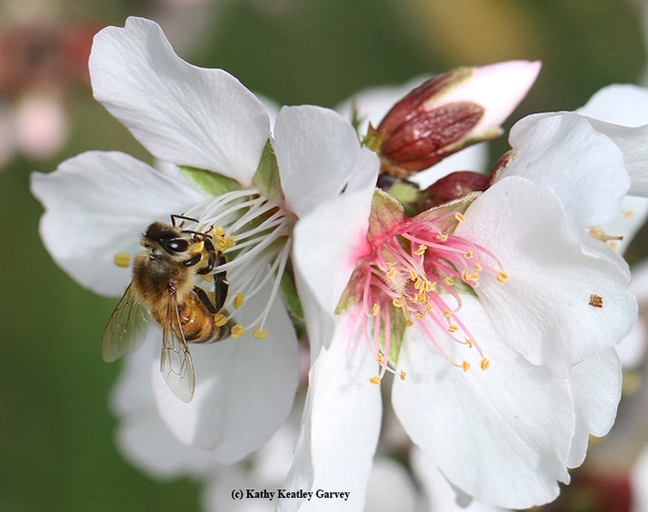
"A" is for almonds. A honey bee pollinating an almond blossom. (Photo by Kathy Keatley Garvey)
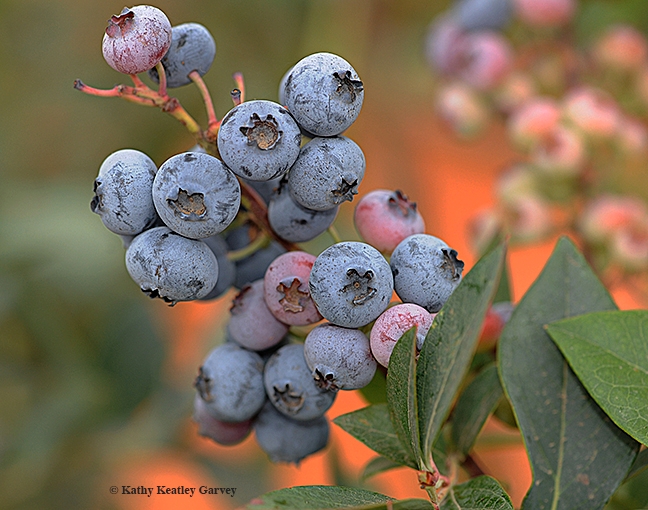
"B" is for blueberries. This is the result of bee pollination. (Photo by Kathy Keatley Garvey)
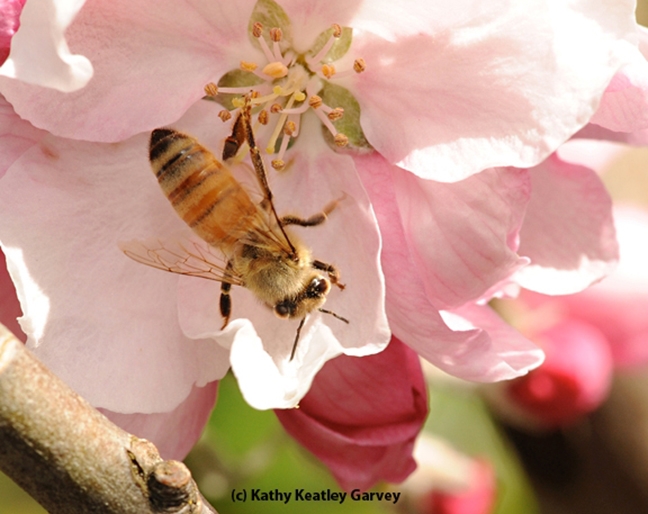
"C" is for cherries. A honey bee pollinating a cherry blossom.(Photo by Kathy Keatley Garvey)
Survey identifies 19 produce candidates for a farm-to-WIC program
A new federal voucher that gives low-income women access to a range of fruits and vegetables could provide unique new marketing opportunities for California growers.
In 2009, the federal Special Supplemental Nutrition Program for Women, Infants and Children (WIC) began distributing monthly cash vouchers to low-income women with children to buy fruits and vegetables. The program reaches almost half of the infants and one-quarter of children under 5 years old in the United States.
A team of UC Cooperative Extension (UCCE) researchers and nutrition advisors has been exploring the possibility of developing a farm-to-WIC program that would link these low-income consumers with local growers. The purpose of such a program would be to increase the consumption of a wide variety of fresh produce, with a focus on locally grown produce when available.
UCCE conducted a survey of produce preferences and buying habits among WIC participants in Tulare, Alameda and Riverside counties in 2010. The full study is published in the January-March 2012 issue of California Agriculture journal.
Based on the results, the UCCE team developed a list of 19 produce items to promote in a possible new farm-to-WIC program. They are:
|
|
|
Although mustard greens and collards were not popular across all sites, the advisors gauged a potential market in Alameda County, so these were retained. Based on write-in responses, oranges were also added.
In California, which has the nation's largest WIC program, 82 local agencies serve about 1.43 million participants at 623 local centers, and WIC participants can redeem their monthly vouchers at 4,000 grocery stores statewide. About 40 percent shop at WIC-only stores, which stock and sell only WIC-authorized foods.
Stocking produce is relatively new to WIC-only stores; before rollout of new WIC food packages in October 2009, these stores were only required to stock limited amounts of fresh carrots. In the survey, most WIC participants (58 percent to 72.3 percent) responded that their preferred stores offered many choices, but fewer participants (18.5 percent to 41 percent) rated the produce quality as “excellent.” Key factors determining purchase decisions were produce quality and freshness, and nutrient value (vitamins and minerals). Cost was relatively less important, possibly because WIC participants procure the produce with the vouchers.
The list has served as a starting point for discussions with growers and WIC vendors.
“The survey showed that WIC participants were interested in purchasing fresh produce with better quality and more variety,” wrote lead author Lucia L. Kaiser, Cooperative Extension specialist in the UC Davis Department of Nutrition, and co-authors, in California Agriculture. “Some WIC participants that we surveyed said they avoided shopping at WIC-only stores in part because these interests were not met.”

A dish made with nopales (cactus pads).
Kearney research station a Fresno County 'gem'
In the waning days of her tenure at the Fresno Bee, food writer Joan Obra devoted an entire column to the UC Kearney Agricultural Research and Extension Center near Parlier.
When she first announced her decision to leave the Bee to return to her family's Hawaii coffee farm, Obra wrote rapturously about the UC Lindcove Research and Extension Center. Her following column said, "I'm not yet done telling you stories." She then recounted treasures she discovered over the years during tours of the 330-acre Kearney station near Parlier.
Obra was fascinated by:
- A demonstration planting of medicinal and culinary herbs from Southeast Asia which includes common and scientific names for the plants.
- Sichuan peppers that she wrote "nearly choked me," planted by UC Cooperative Extension farm advisor Richard Molinar at Kearney as a possible California specialty crop.
- A late summer field day where she tried more than 20 varieties of mini watermelons. "The red flesh of the Little Deuce Coupe was pleasingly crunchy but not super sweet. And the sunny interior of the Mini Yellow was sweeter but not as crisp," Obra wrote.
- Jujubes. Not the artificially flavored candy that sticks to your teeth, but small apple-like fruit important in Asian communities.
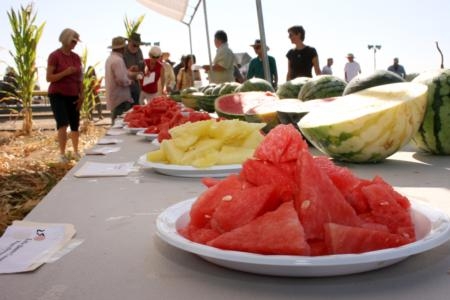
A watermelon field day at Kearney. (Photo: B. Dawson)
Bay Area newspaper features giant watermelons
The San Francisco Chronicle devoted space in the Sunday paper for a story about gigantic watermelons cultivated by a Santa Clara County UC Cooperative Extension Master Gardener.Master Gardener Mike Kent sent away for giant watermelon seeds and tended a patch at the program's two-acre research garden, "Nine Palms Ranch." The result was five supersized watermelons including a 103.2-pound behemoth that was carved up and shared at a September tasting and open house.
According to the story, written for the Chron by Master Gardener Laramie Treviño, UCCE farm advisor Aziz Baameur was on hand for the watermelon tasting. He said the monstrous melon was surprisingly sweet, and while it is a curiosity, the size isn't practical for most consumers. In fact, watermelon breeding programs are focused on smaller, rather than larger, fruit.
"Most people don't want 40-50-pound watermelons - they'll hurt their backs trying to put them in their cars," Baameur was quoted. "If you have a small yard, that is all you're going to grow."
The newest trend is seedless "personal" watermelons, about the size of a cantaloupe. They are easy to carry and fit comfortably in the refrigerator. Many varieties of personal watermelons have been found by UCCE advisors to have very thin rind and bright red, crispy and intensely sweet flesh.

Small-sized watermelons are more popular than monstrosities.

